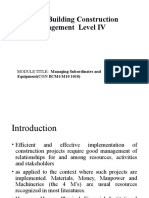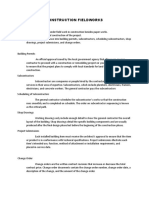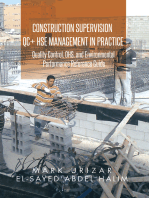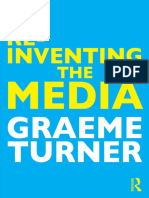CME Module - 02
Uploaded by
YASHWANTH.M.KCME Module - 02
Uploaded by
YASHWANTH.M.KConstruction Management and Entrepreneurship (18CV51)
MODULE-II
RESOURCE MANAGEMENT
Construction companies face the challenge of delivering often complex projects to a schedule,
within a budget, and hopefully with a reasonable profit margin.
Resource management is the process of planning the resources necessary to meet
the objectives of the project, and to satisfy the client’s requirements.
Fundamental to resource management is real-time visibility of
• what resources are needed,
• what resources are available,
• where resources are located, and the
• ability to reschedule those resources accordingly
Construction resources might include
• Products and materials
• Construction plant, tools and equipment
• Human resources
• Space and facilities
• Subcontractors
• Finance
A resource management plan can be used to
Ensure resource availability and resolve resource conflicts
Optimise time, effort and cost
Ensure workers with the right skills are available
Identify limitations, such as site access, weather conditions, and so on
Reassign resources in response to circumstances
Track resources utilisation to avoid excessive resourcing or under-utilisation
Department of Civil Engineering, MIT Mysore
Page 1
Construction Management and Entrepreneurship (18CV51)
List key information about the required resources for each activity
• Type of activity
• Start date and duration of the activity
• Activity owner
• Resource type and quantity required
• Source/supplier of each resource type
• Equipment required
• Cost estimates for each of the resources to be supplied
• Risk mitigation
Successful resource management requires
• Access to up-to-date project plan with clear definition of different phases of
work, activityand scheduling
• Understanding the types of resources that are needed
• Understanding the availability and optimum utilisation of resources
• Understanding the potential for developing resources for new uses
• Understanding of the lead time required to ensure that resources are available
when needed
• The ability to redeploy resources if works need to be accelerated, or if works are
• Completed
Automated resource management
Systems can improve companies’ overall efficiency,
• replacing less efficient data collection methods such as
• paper forms,
• Spreadsheets, and so on.
Some of the features automated resource management can incorporate include
Automated calculations
Ability for managers to simulate and test different scenarios
Re-evaluation and re-calculation as decisions change
Real-time resource utilisation tracking
Resource allocations can be assessed and approved quickly online
Department of Civil Engineering, MIT Mysore
Page 2
Construction Management and Entrepreneurship (18CV51)
Access to real-time information via mobile device
Online collaboration between sites, offices, partners, subcontractors, and so on
CONSTRUCTION LABOUR
They are employed in the construction industry and work predominantly on
construction sites and are typically engaged in aspects of the industry other than design or
finance The term includes general construction workers, also referred to as labourers and
members of specialist trades such electricians, carpenters and plumbers.
What does a construction worker do?
Construction is an industry that requires working at ever-changing locations and
work environments. This profile refers to general construction workers. Others at a
construction site include electricians, carpenters and plumbers.
Some of the main duties of a general construction worker are to
• Install various commercial, industrial or residential systems
• Ensure that projects conform to building codes and regulations
• Use, clean and maintain various types of equipment
• Supervise or apprentice other workers
The construction industry is divided into three major segments
Construction of buildings contractors, or general contractors, build
residential, industrial, commercial, and other buildings.
Heavy and civil engineering construction contractors build sewers, roads,
highways, bridges, tunnels, and other projects.
Specialty tradecontractors areengaged in specialized activities such as
carpentry, painting, plumbing, and electrical work.
Department of Civil Engineering, MIT Mysore
Page 3
Construction Management and Entrepreneurship (18CV51)
WAGES OF CONSTRUCTION WORKERS
Workers are paid very low wages. Net worth of wages is reduced considerably due to
periods of unemployment.
Two methods of making wage payment to labour
Time rate system
Piece rate system
Time rate system
• Suitable payment fixed per unit of time that labour is engaged on the work.
• Unit of time may be hour, day, week, fortnight or month.
• In India, Rate of payment for casual labour is determined per day and that of
regular employees per month.
Piece rate system
• Payment is based on output or production of workers
• Payment is made at the agreed rate for actual quantum of work done by
each labourer
• Advantage of this system is Good worker can make more money by increasing
his output
Piece rate system
• Payment is based on output or production of workers.
• Payment is made at the agreed rate for actual quantum of work done by
each labourer.
• The main Advantage of this system is Good worker can make more money
by increasing his output.
Department of Civil Engineering, MIT Mysore
Page 4
Construction Management and Entrepreneurship (18CV51)
TYPES OF CONSTRUCTION WORKERS
Followings are the different types of construction workers/labours.
• Pipe fitter
• Layers Sheet metal worker
• Steam fitters
• Painters
• Paperhangers
• Drywall installers
• Tile Installers
• Tapers
• Cement Masons
• Concrete finishers
• Segmental pavers
• Brick masons
• Stone masons
• Insulation workers
• Duct workers
LABOUR PRODUCTIVITY
Productivity is the relationship between the outputs generated from a system and the
inputs that are used to create those outputs
Mathematically,
P = Output/Input
P = (Earned hours / Worked hours)
Examples
• Kilograms of rebar fixed per man/day
• Cu.m Concrete poured per man/day
• Sq.m of formwork placed per man/day
• Sq.m of block laid per man/day
Department of Civil Engineering, MIT Mysore
Page 5
Construction Management and Entrepreneurship (18CV51)
Construction Equipment:
Good project management in construction must vigorously pursue the efficient
utilization of labour, material and equipment. The use of new equipment and innovative
methods has made possible wholesale changes in construction technologies in recent
decades. The selection of the appropriate type and size of construction equipment often
affects the required amount of time and effort and thus the job-site productivity of a project.
It is therefore important for site managers and construction planners to be familiar with the
characteristics
of the major types of equipment most commonly used in construction.
Classification of construction equipment:
• EARTHWORK EQUIPMENTS
• CONCRETING EQUIPMENTS
• HOISTING EQUIPMENTS
Types of Earthwork Equipment
1. Backhoe
2. Front shovel
3. Dragline
4. Clamshell
5. Dozers
6. Roller compactor
7. Scraper
8. Dumper
9. Grader
1. Backhoe:-
Backhoes are mainly used to clean up construction areas, to dig holes in the ground,
to smooth uneven ground, to make trenches, ditches and to help remove deep roots
from trees.
Department of Civil Engineering, MIT Mysore
Page 6
Construction Management and Entrepreneurship (18CV51)
2. Front shovel:-
Front shovel are mainly used for excavation purposes above its own track or wheel
level. They are suitable for heavy positive cutting in all types of dry soils.
3. Dragline:-
They are used for bulk excavation below its track level in loose soils, marshy land and
areas containing water.
4. Clamshell:-
It consists of a hydraulically controlled bucket suspended from a lifting arm. It is
mainly used for deep confined cutting in pits and trenches.
Department of Civil Engineering, MIT Mysore
Page 7
Construction Management and Entrepreneurship (18CV51)
5. Dozers:-
They are used for moving earth up to a distance of about 100m and act as a towing
tractor and pusher to scraper machines. They can be track-mounted or wheel-mounted.
6. Roller compactor:-
Roller compactor is mainly used to for compaction of earth and other materials in large
works of highways, canals and airports.
7. Scraper:-
They are used for site levelling, loading, hauling over distances varying between
150m- 900m. They may be towed, two-axle or three-axle type.
Department of Civil Engineering, MIT Mysore
Page 8
Construction Management and Entrepreneurship (18CV51)
8. Dumper:-
It is used for horizontal transportation of materials on and off sites. Large capacity
dumpers are used in mines and quarries.
9. Grader:-
It is used for grading and finishing the upper surface of the earthen formations and
embankments. They usually operate in the forward direction.
Types of Concreting Equipment:-
1. Concrete batching and mixing plant
2. Concrete mixers
3. Concrete transit mixers
4. Concrete pumps
Department of Civil Engineering, MIT Mysore
Page 9
Construction Management and Entrepreneurship (18CV51)
1. Concrete batching and mixing plant:-
They are mainly used for weighing and mixing large quantity of concrete constituents.
Capacity:-20cum/hr-250cum/hr.
2. Concrete mixers:-
They are mainly used for mixing small quantities of concrete constituents.
Capacity:-200lt/batch (small mixers) 200-750l/batch (large mixers).
3. Concrete transit mixers:-
They are mainly used for transporting concrete from batching point.
Capacity: - 3cum-9cum.
Department of Civil Engineering, MIT Mysore
Page 10
Construction Management and Entrepreneurship (18CV51)
4. Concrete pumps:-
They are used for horizontal and vertical transportation of large volumes of concrete in
short duration.
Capacity: - 30cum/hr (ordinary construction), 120cum/hr (specialized construction).
Types of Hoisting Equipment:-
It constitutes a group of equipment which are employed mainly for lifting or lowering of unit
load and other. This group of equipment’s can be further sub classified into:
1. Hoists:-
Boom hoists
Chain hoists
Electric hoists
2. Cranes:-
Derrick
Crane Mobile
Crane Tower
Crane
1. Boom Hoist:-
Boom hoists are used to lift weights on the hooks that are attached to the special
metal ropes designed to bear maximum loads. Boom hoist is mostly used as industrial
machine where it loads the weight on containers.
Department of Civil Engineering, MIT Mysore
Page 11
Construction Management and Entrepreneurship (18CV51)
2. Chain Hoist:-
Chain hoists are quite common example of hoist system and it can be seen at most of
the construction and industrial purposes. Basically, chain hoist consists of chain rope
and pulley that is used to move the load from up to down.
3. Electric Hoist:-
Electric hoist is modernized form of chain and boom hoist mostly used in the
industries for fast working. It is very much popular in material handling industries
because it saves labour costs by handling maximum loads at a time with no damage
threats.
4. Tractor Hoist:-
Tractor hoist consist of a boom that is attached with base of tractor and a hook with
rope is installed on this boom that can operated through driver controls.
Department of Civil Engineering, MIT Mysore
Page 12
Construction Management and Entrepreneurship (18CV51)
Cranes:-
Cranes are considered to be one of the most important equipment used in construction
due to their key role in performing lifting tasks all over the construction site.
Plenty of crane models are available in different shapes and sizes, though, they usually
fall into three categories,
1. Derrick Cranes
2. Mobile Cranes
3. Tower Cranes
1. Derrick Cranes:-
• Preferable for high-rise and apartment buildings.
• Can be used for both long term and short term projects.
• Cheaper than mobile and tower cranes.
• Not considered to be safe.
• Used when clearance is inadequate for the other units and sufficient space
is unavailable for the erection of a tower foundation.
2. Mobile Cranes:-
Adequate for all types of structures (up to 107 m)
Used for shorter projects duration (less than 4 months).
Not considered to be very safe due to lack of safety devices o limited switches
to prevent overloading.
Can operate in muddy terrain but requires good ground conditions.
Needs adequate operating clearance.
Department of Civil Engineering, MIT Mysore
Page 13
Construction Management and Entrepreneurship (18CV51)
3. Tower Cranes:-
Preferable for high-rise (over 107 m).
Used for longer project duration.
Considered to be very safe due to the presence of limit switches.
Can operate where ground conditions are poor.
Does not need adequate operating clearance.
Department of Civil Engineering, MIT Mysore
Page 14
Construction Management and Entrepreneurship (18CV51)
Material Management
Material management is the Process of management concerned with planning, organizing
and controlling of the flow of materials to, though, and out of an organization in an
integrated fashion.
MATERIALS
Any commodity used directly or indirectly in producing a product or service considered as
the lifeblood and heart of any manufacturing system.
CLASSIFICATIONS OF MATERIALS
1. PURCHASED MATERIALS: - These are the raw materials, components,
spare parts, and items that are used and usually do not appear in the end product.
2. WORK-IN PROCESS MATERIALS: - These are materials that are in the
semi- finished stage.
3. FINISHED GOODS: - These are the final products which are ready for
final delivery or distribution.
4. SUPPLIES: - These are the consumable goods.
ACTIVITIES INVOLVED IN MATERIALS MANAGEMENT
a.) Materials Requirements
Planning b.) Purchasing
c.) Inventory
Control d.)
Expediting
e.) Transportation
f.) Materials Handling
a.) Materials Requirements planning: - Encompasses the identifying,
quantifying and scheduling the acquisition of materials and equipment. Necessary
function in any organization as inventory of materials involved about 60% of the total
investment of the organization.
b.) Purchasing: - -holds the responsibility for procuring goods for the project in
alignment with the specifications, standardization and in compliance with the project
schedule and budget.
Functions:
1. To select proper supplier for the materials requisitioned, before placing an order.
2. To negotiate about the price of the materials from the supplier.
3. To assure the quality of materials and should not be compromised with the cost.
Department of Civil Engineering, MIT Mysore
Page 15
Construction Management and Entrepreneurship (18CV51)
4. The materials should be purchased in right quantity and quality at proper time and
at cheapest cost as possible.
5. To set proper purchase policy and procedures
Importance:
50% to 60% of sales turnover is spent on the purchase of various materials every 1%
saving achieved in purchasing results to about 5% profit for an organization.
c) Inventory Control: - Method where all stocks of goods are properly and promptly
issued, accorded and preserved in the best interest of the firm. Monitor the stock of goods
used for production, distribution and captive (self) consumption.
INVENTORY - a physical resource that a firm holds in stock with the intent of
selling it or transforming it into a more valuable state.
Functions:
To meet anticipated demand
To smooth production requirements
Protect against stock outs
To help hedge against price increase
To permit operations
IMPORTANCE:-
Inventory Control can help the business be more profitable by identifying the types
of inventory in the warehouse in terms of profitability.
Liquidating those unwanted inventory, and understanding the carrying cost such
as storage, insurance, tax, etc. to minimize the cost incurred.
d. EXPEDITING: - The continuous monitoring as well as ascertaining and maintaining the flow and
supply of materials to prevent stock outs and stoppage of production.
Factors affecting expediting:
* Insufficient or zero inventories
* Failure of materials handling devices
* Uncertainty in demand and production quantity.
e. TRANSPORTATION: -Involves the using of the safest and most economical means to
transport the materials to the site where they are needed
Modes of Transportation
Aviation
Land
Transport Ship
Transport
Department of Civil Engineering, MIT Mysore
Page 16
Construction Management and Entrepreneurship (18CV51)
Pipeline
1) INTERMODAL TRANSPORT: - System of transport where by two or more models
are used to transport the same loading unit in an integrated manner.
2) MULTIMODAL TRANSPORT: - Continuous movement of goods by more than
one means of transport.
f. MATERIALS HANDLING: - The movement of materials at the lowest possible
cost through the use of proper method and equipment. Applies the movement of raw
materials, parts in process, finished goods, packing materials, and disposal of scraps.
Importance:
Reduces delays and damage.
Promotes safety and improve working conditions.
Promotes productivity.
Control inventory.
Reduces total cost of production as materials handling uses about 20%-25% of total
manufacturing cost.
MATERIALS HANDLING EQUIPMENT:-
Automated guided
vehicles Industrial trucks
Monorails and other guided
vehicle Conveyors
Cranes and hoist
Why firms have implemented Materials Management System?
The Construction Industry Institute concluded that the labour productivity could be
improved by 6% and can produce 4-6% in additional savings.
Reduces the overall cost of
materials Better handling of
materials
Reduction in duplicated orders
Materials will be onsite when
needed Improvement in project
schedule
Quality control
Better relationship with
suppliers Reduces materials
surplus
Better cash flow management
END
Department of Civil Engineering, MIT Mysore
Page 17
You might also like
- On-Site Building Construction Management Level IV: MODULE TITLE: Managing Subordinates andNo ratings yetOn-Site Building Construction Management Level IV: MODULE TITLE: Managing Subordinates and58 pages
- CONSTRUCTION ENGINEERING AND MANAGEMENT (WEEK 1)- Introduction To Construction ManagementNo ratings yetCONSTRUCTION ENGINEERING AND MANAGEMENT (WEEK 1)- Introduction To Construction Management9 pages
- CE 206 - Construction A Dynamic IndustryNo ratings yetCE 206 - Construction A Dynamic Industry45 pages
- Different Aspects of Construction ProjectsNo ratings yetDifferent Aspects of Construction Projects50 pages
- Construction methods and equipments managementNo ratings yetConstruction methods and equipments management31 pages
- CN4103 - Construction Eeuipments and ManagementNo ratings yetCN4103 - Construction Eeuipments and Management166 pages
- Lec.1. Intro To Construction Management & PlanningNo ratings yetLec.1. Intro To Construction Management & Planning34 pages
- Module 1 - Introduction to Construction ManagementNo ratings yetModule 1 - Introduction to Construction Management20 pages
- Principles of Construction Management Lesson 1No ratings yetPrinciples of Construction Management Lesson 167 pages
- Objective Objective: Construction Technology Construction ManagementNo ratings yetObjective Objective: Construction Technology Construction Management2 pages
- 3 Construction Equipment Management (2)No ratings yet3 Construction Equipment Management (2)50 pages
- An Overview of Construction Equipments Soil Properties and Types - 1591957188No ratings yetAn Overview of Construction Equipments Soil Properties and Types - 15919571886 pages
- Construction-Materials-Methods-and-Techniques-Chapter-1 HighlightedNo ratings yetConstruction-Materials-Methods-and-Techniques-Chapter-1 Highlighted18 pages
- B o o KS: (C 2 0 11 - 20 1 3) : Construction ManagementNo ratings yetB o o KS: (C 2 0 11 - 20 1 3) : Construction Management2 pages
- Construction Management, Project ManagementNo ratings yetConstruction Management, Project Management10 pages
- CONSTRUCTION INDUSTRY, Construction Project ParticipantsNo ratings yetCONSTRUCTION INDUSTRY, Construction Project Participants5 pages
- Construction Machinery: - Types, Procurement & MaintenanceNo ratings yetConstruction Machinery: - Types, Procurement & Maintenance110 pages
- BJTC 2023 Construction Technology: - Introduction To Construction & Construction IndustryNo ratings yetBJTC 2023 Construction Technology: - Introduction To Construction & Construction Industry31 pages
- Group 8_ Basement Construction, Materials Handling and MechanizationNo ratings yetGroup 8_ Basement Construction, Materials Handling and Mechanization4 pages
- [Ebooks PDF] download (eBook PDF) Construction Management, 5th Edition by Daniel W. Halpin full chapters100% (2)[Ebooks PDF] download (eBook PDF) Construction Management, 5th Edition by Daniel W. Halpin full chapters41 pages
- Construction Equipment and Plant MGT Chapter 1No ratings yetConstruction Equipment and Plant MGT Chapter 113 pages
- Construction Supervision Qc + Hse Management in Practice: Quality Control, Ohs, and Environmental Performance Reference GuideFrom EverandConstruction Supervision Qc + Hse Management in Practice: Quality Control, Ohs, and Environmental Performance Reference Guide5/5 (2)
- Mechanical Production Engineer Success: Careers, Interview Q&A, and TerminologyFrom EverandMechanical Production Engineer Success: Careers, Interview Q&A, and TerminologyNo ratings yet
- File_1730703753_202411101825_brochure_fileNo ratings yetFile_1730703753_202411101825_brochure_file3 pages
- File_1730864004_202411081036_fdpschedule_fileNo ratings yetFile_1730864004_202411081036_fdpschedule_file2 pages
- File_1730864004_202411071005_brochure_fileNo ratings yetFile_1730864004_202411071005_brochure_file2 pages
- File_1730703753_202411101843_fdpschedule_fileNo ratings yetFile_1730703753_202411101843_fdpschedule_file1 page
- Environmental Impact and Life Cycle Assessment: Department of Civil EngineeringNo ratings yetEnvironmental Impact and Life Cycle Assessment: Department of Civil Engineering21 pages
- Introduction To Python Programming 1721886042100% (1)Introduction To Python Programming 1721886042250 pages
- Market Issues For Recycled Aggregates: Presented byNo ratings yetMarket Issues For Recycled Aggregates: Presented by22 pages
- What Is Structural Health Monitoring: SensorsNo ratings yetWhat Is Structural Health Monitoring: Sensors4 pages
- PET Bottles For Eco-Friendly Building in Sustainable DevelopmentNo ratings yetPET Bottles For Eco-Friendly Building in Sustainable Development10 pages
- Sustaining An Ethnic Soft Drink - Paper Boat: Brand Positioning and Consumer BehaviorNo ratings yetSustaining An Ethnic Soft Drink - Paper Boat: Brand Positioning and Consumer Behavior8 pages
- Online Registration System of Companies-1No ratings yetOnline Registration System of Companies-17 pages
- MARKETING & MANAGEMENT From Rural PerspectiveNo ratings yetMARKETING & MANAGEMENT From Rural Perspective8 pages
- COA Circular No. 2018 002 PROPERTY INVENTORYNo ratings yetCOA Circular No. 2018 002 PROPERTY INVENTORY7 pages
- Kapan Profesi Auditor Internal Diminati? Pengujian Eksperimen Terhadap Label Pekerjaan, Peran Auditor Internal Dan Prospek KarirNo ratings yetKapan Profesi Auditor Internal Diminati? Pengujian Eksperimen Terhadap Label Pekerjaan, Peran Auditor Internal Dan Prospek Karir18 pages
- 1.TRUE 2.TRUE 3.TRUE 4.false 5.TRUE 6.TRUE 7.false 8.TRUE 9.TRUE 10. FalseNo ratings yet1.TRUE 2.TRUE 3.TRUE 4.false 5.TRUE 6.TRUE 7.false 8.TRUE 9.TRUE 10. False5 pages
- General Information Sheet (Gis) : FOR THE YEAR - 2020 - Non-Stock CorporationNo ratings yetGeneral Information Sheet (Gis) : FOR THE YEAR - 2020 - Non-Stock Corporation7 pages
- Chopra Industries (P) Ltd.-Unit-Iv: Quality Management System ProcedureNo ratings yetChopra Industries (P) Ltd.-Unit-Iv: Quality Management System Procedure5 pages
- What Is The Importance of Financial Management?: We've Switched Our Classes To Live Online. For More Covid-19 UpdatesNo ratings yetWhat Is The Importance of Financial Management?: We've Switched Our Classes To Live Online. For More Covid-19 Updates7 pages
- MKT 460 Section - 02 Launching of IKEA Bangladesh: Presented byNo ratings yetMKT 460 Section - 02 Launching of IKEA Bangladesh: Presented by29 pages
- On-Site Building Construction Management Level IV: MODULE TITLE: Managing Subordinates andOn-Site Building Construction Management Level IV: MODULE TITLE: Managing Subordinates and
- CONSTRUCTION ENGINEERING AND MANAGEMENT (WEEK 1)- Introduction To Construction ManagementCONSTRUCTION ENGINEERING AND MANAGEMENT (WEEK 1)- Introduction To Construction Management
- Lec.1. Intro To Construction Management & PlanningLec.1. Intro To Construction Management & Planning
- Module 1 - Introduction to Construction ManagementModule 1 - Introduction to Construction Management
- Objective Objective: Construction Technology Construction ManagementObjective Objective: Construction Technology Construction Management
- An Overview of Construction Equipments Soil Properties and Types - 1591957188An Overview of Construction Equipments Soil Properties and Types - 1591957188
- Construction-Materials-Methods-and-Techniques-Chapter-1 HighlightedConstruction-Materials-Methods-and-Techniques-Chapter-1 Highlighted
- B o o KS: (C 2 0 11 - 20 1 3) : Construction ManagementB o o KS: (C 2 0 11 - 20 1 3) : Construction Management
- CONSTRUCTION INDUSTRY, Construction Project ParticipantsCONSTRUCTION INDUSTRY, Construction Project Participants
- Construction Machinery: - Types, Procurement & MaintenanceConstruction Machinery: - Types, Procurement & Maintenance
- BJTC 2023 Construction Technology: - Introduction To Construction & Construction IndustryBJTC 2023 Construction Technology: - Introduction To Construction & Construction Industry
- Group 8_ Basement Construction, Materials Handling and MechanizationGroup 8_ Basement Construction, Materials Handling and Mechanization
- [Ebooks PDF] download (eBook PDF) Construction Management, 5th Edition by Daniel W. Halpin full chapters[Ebooks PDF] download (eBook PDF) Construction Management, 5th Edition by Daniel W. Halpin full chapters
- Construction Supervision Qc + Hse Management in Practice: Quality Control, Ohs, and Environmental Performance Reference GuideFrom EverandConstruction Supervision Qc + Hse Management in Practice: Quality Control, Ohs, and Environmental Performance Reference Guide
- Mechanical Production Engineer Success: Careers, Interview Q&A, and TerminologyFrom EverandMechanical Production Engineer Success: Careers, Interview Q&A, and Terminology
- Environmental Impact and Life Cycle Assessment: Department of Civil EngineeringEnvironmental Impact and Life Cycle Assessment: Department of Civil Engineering
- Market Issues For Recycled Aggregates: Presented byMarket Issues For Recycled Aggregates: Presented by
- PET Bottles For Eco-Friendly Building in Sustainable DevelopmentPET Bottles For Eco-Friendly Building in Sustainable Development
- Sustaining An Ethnic Soft Drink - Paper Boat: Brand Positioning and Consumer BehaviorSustaining An Ethnic Soft Drink - Paper Boat: Brand Positioning and Consumer Behavior
- Kapan Profesi Auditor Internal Diminati? Pengujian Eksperimen Terhadap Label Pekerjaan, Peran Auditor Internal Dan Prospek KarirKapan Profesi Auditor Internal Diminati? Pengujian Eksperimen Terhadap Label Pekerjaan, Peran Auditor Internal Dan Prospek Karir
- 1.TRUE 2.TRUE 3.TRUE 4.false 5.TRUE 6.TRUE 7.false 8.TRUE 9.TRUE 10. False1.TRUE 2.TRUE 3.TRUE 4.false 5.TRUE 6.TRUE 7.false 8.TRUE 9.TRUE 10. False
- General Information Sheet (Gis) : FOR THE YEAR - 2020 - Non-Stock CorporationGeneral Information Sheet (Gis) : FOR THE YEAR - 2020 - Non-Stock Corporation
- Chopra Industries (P) Ltd.-Unit-Iv: Quality Management System ProcedureChopra Industries (P) Ltd.-Unit-Iv: Quality Management System Procedure
- What Is The Importance of Financial Management?: We've Switched Our Classes To Live Online. For More Covid-19 UpdatesWhat Is The Importance of Financial Management?: We've Switched Our Classes To Live Online. For More Covid-19 Updates
- MKT 460 Section - 02 Launching of IKEA Bangladesh: Presented byMKT 460 Section - 02 Launching of IKEA Bangladesh: Presented by





















































































































